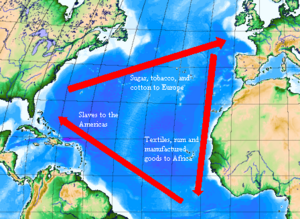Slavery in Britain facts for kids
Slavery in Britain existed a very long time ago, even before the Romans arrived. It continued until the 11th century. After the Normans took over England, the old system of slavery slowly changed into something called serfdom. This meant slaves were no longer seen as separate in English law. By the mid-1100s, slavery as it was known before the Normans had mostly disappeared. However, other types of forced work continued for hundreds of years.
Later, between the 1600s and 1800s, British traders played a big part in the Atlantic slave trade. But no law was ever passed in England that made slavery legal. In a famous court case in 1772, known as the Somerset case, a judge named Lord Mansfield decided something important. He said that because English law didn't recognize slavery, James Somerset, a slave who had come to England and escaped, couldn't be forced back to Jamaica to be sold. So, James was set free. In Scotland, people who worked in coal mines were still forced to work until 1799. A new law then made this type of forced labor illegal and gave them freedom.
A strong movement to end slavery, called the abolitionist movement, grew in Britain during the 1700s and 1800s. This led to the Slave Trade Act 1807, which stopped the trading of slaves in the British Empire. But it wasn't until the Slavery Abolition Act 1833 that slavery itself was completely banned in British lands overseas.
Contents
- Slavery in Britain: A Look Back
- Early Slavery: Before 1066
- Norman and Medieval England
- Forced Labor and Transportation
- Forced Labor in Scottish Coal Mines
- Barbary Pirates and European Slaves
- Enslaved Africans and the Atlantic Trade
- Court Decisions on Slavery
- Ending Slavery
- Economic Impact of Slavery
- Modern Slavery Today
- See also
Slavery in Britain: A Look Back
Historically, many Britons were forced into slavery. This often happened because rich traders and powerful leaders sold them. Foreign invaders, like the Romans during their conquest, also enslaved people.
Much later, British traders became very involved in the Atlantic slave trade. This was part of a system called the triangular trade. Ships would carry enslaved people from West Africa to European colonies in the Americas, especially the British colonies in the West Indies. There, the enslaved people were sold to work on plantations. The ships would then bring goods like sugar and tobacco back to Britain. Some plantation owners brought enslaved people to Britain, but many of them ran away.
A long fight to end slavery, led by people like Thomas Clarkson and William Wilberforce, finally succeeded. The British Parliament passed the Slave Trade Act of 1807, which made trading slaves illegal. The Royal Navy's West Africa Squadron helped to stop slave ships. Britain also encouraged other countries to stop the slave trade.
In 1772, a court case called Somerset v Stewart decided that slavery had no legal basis in English law. This built on an earlier case from the time of Queen Elizabeth I. These cases meant that slavery wasn't officially recognized in English law. Even so, actual slavery continued in Britain for a while, with thousands of enslaved people, mostly working as house servants. Most historians agree that slavery in Britain ended around 1800.
Slavery in other parts of the British Empire was not affected by these rulings. In fact, it grew quickly, especially in the Caribbean colonies. Slavery was finally ended in directly ruled colonies, like Canada, from 1834. This happened under the Slavery Abolition Act 1833, which involved buying the freedom of enslaved people from their owners.
Early Slavery: Before 1066
Slavery was common in Britain even before the Romans arrived. Many native Britons were sold to other countries. After the Roman conquest of Britain, slavery became even more widespread.
After the Roman Empire left Britain, the Angles and Saxons continued the practice of slavery. One early story tells of fair-haired boys from York seen in Rome by Pope Gregory the Great.
Vikings often raided British lands and took people as slaves. They also traded with different groups like the Gaelic and Saxons. Sometimes, Saxon slave traders worked with Norse traders, selling Britons to the Irish. In 870, Vikings captured a stronghold called Alt Clut. Most of its people were taken to slave markets in Dublin.
Over time, Anglo-Saxons started to oppose selling their own people abroad. A law from Ine of Wessex said that anyone selling a countryman overseas would face a penalty. However, laws and money problems still led to people becoming enslaved. In the 11th century, a slave trade still operated from Bristol.
Old records from Bodmin in Cornwall show the names of slaves who were set free in the 9th and 10th centuries. This proves that slavery existed there and that many Cornish slave owners eventually freed their slaves.
Norman and Medieval England
The Domesday Book, a survey from 1086, shows that over 10% of England's population were slaves.
Even though there were no laws against slavery, William the Conqueror made a rule against selling slaves overseas.
In 1102, a Church meeting in London, led by Anselm, declared that no one should continue the "infamous business" of selling people "like animals." However, this meeting couldn't make laws on its own.
Writers from that time noted that the Scottish and Welsh still took captives as slaves during raids. This practice was less common in England by the 12th century. Some historians believe that by about 1200, slavery had mostly disappeared in the British Isles.
Other experts argue that some forms of forced labor continued in England between the 12th and 17th centuries. These workers were called "serfs" or "villeins." Unlike slaves, serfs could not be bought and sold separately from their land. This made serfdom more like renting land today than true slavery. However, forced labor still happened, like when over a thousand children from Wales were taken as "servants" in 1401.
Forced Labor and Transportation
Transportation to colonies was a punishment for crimes in England from the 1600s to the 1800s. People were sent to work on government projects or for private individuals without pay. Women often worked as servants or farm laborers. Like enslaved people, these "indentured servants" could be bought and sold. They couldn't marry without permission and could be physically punished. However, they did have some limited rights, unlike enslaved people who had none.
This practice of sending English subjects overseas started with the Vagabonds Act 1597. One of the first records of someone being transported was in 1607. A young worker was sent to Virginia for running away with his master's goods.
Transportation became more common after the Piracy Act 1717. Criminals were sent to North America until 1776. After the American Revolution, they were sent to Australia from 1787 to 1868.
After the Irish Rebellion of 1641, many Irish people were forced to move within Ireland or were transported to colonies in the West Indies and North America. Irish, Welsh, and Scottish people were sent to work on sugar plantations in Barbados during this time.
In the early colonial period, many Gypsy people from Scotland and England were also transported as slaves to North America and the Caribbean.
Forced Labor in Scottish Coal Mines
For nearly 200 years, Scottish coal miners were tied to their employers by a law from 1606. The Colliers and Salters (Scotland) Act 1775 stated that "many colliers and salters are in a state of slavery." It announced their freedom, but it was complicated. Those starting work after 1775 would not become slaves. Those already enslaved could apply for freedom after 7 or 10 years, but few could afford it. A new law in 1799 finally made this type of forced labor illegal and gave them full freedom.
Barbary Pirates and European Slaves
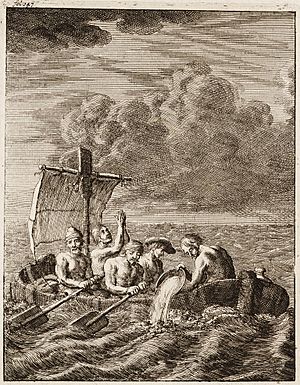
From the 1500s to the 1800s, it's thought that between 1 million and 1.25 million Europeans were captured and sold as slaves by Barbary pirates. These pirates came from the Barbary Coast in North Africa. There are stories of Barbary slave raids all over Western Europe, including England and even as far north as Iceland.
Villagers along the south coast of England asked the king to protect them from being kidnapped by these pirates.
Enslaved Africans and the Atlantic Trade
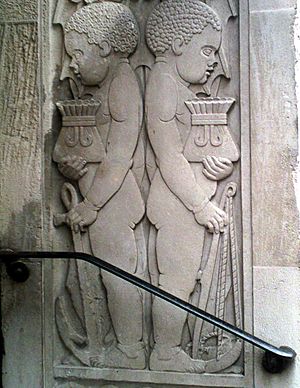
Sir John Hawkins of Plymouth is known as the "Pioneer of the English Slave Trade." In 1554, he formed a group of traders. He sailed to the Caribbean, captured a Portuguese slave ship, and sold the 300 enslaved people in Santo Domingo. On a second trip in 1564, his crew captured 400 Africans and sold them, making a large profit. He made several more voyages, transporting thousands of enslaved Africans. English involvement in the Atlantic slave trade paused after 1568 but started again in the 1640s.
By the mid-1700s, London had the largest African population in Britain. Historians estimate about 10,000 Black people lived in Britain then. Many enslaved Africans in Britain ran away from their masters. Their masters would often put ads in newspapers offering rewards for their return.
Some formerly enslaved Black people became well-known in British society. Ignatius Sancho (1729–1780) opened a shop in Westminster. He was famous for his poetry and music. He was friends with famous people like the writer Laurence Sterne. Others, like Olaudah Equiano and Ottobah Cugoano, were also well-known and actively fought to end slavery in Britain.
The Triangular Trade System
By the 1700s, the slave trade became very profitable for port cities like Bristol, Liverpool, and Glasgow. This was part of the "Triangular trade." Merchant ships left Britain with goods. These goods were traded in West Africa for people captured by local rulers. The enslaved people were then transported across the Atlantic on the terrible "Middle Passage" and sold for labor on plantations. The ships would then load up with products made by enslaved labor, like cotton, sugar, and rum, and return to Britain to sell them.
The Isle of Man was also involved in this trade. Goods from the slave trade were bought and sold there, and Manx traders and ships took part.
Court Decisions on Slavery
No law was ever passed in England that made slavery legal. This caused problems when English people brought enslaved people they had legally bought in colonies back home.
An English court case in 1569 said that English law could not recognize slavery. This idea was later supported in 1701 when a judge ruled that an enslaved person became free as soon as they arrived in England.
In 1705, a judge named John Holt stated that "by the common law no man can have a property in another."
However, in 1729, two important legal officials, Philip Yorke and Charles Talbot, gave their opinion. They said that an enslaved person's legal status didn't change just by coming to Britain. This opinion was given because Holt's earlier decision caused worry among slave owners. Slavery was also accepted in Britain's many colonies.
But in 1763, another judge, Lord Henley, said that "as soon as a man sets foot on English ground he is free."
The most famous case was R v. Knowles, ex parte Somersett in 1772. James Somersett was enslaved by a customs officer from Boston. They came to England, and James escaped. He was captured and put on a ship going to Jamaica. Three British people who wanted to end slavery asked the court for help. One of James's lawyers argued that English common law did not allow slavery. On June 22, 1772, Lord Mansfield gave his judgment.
What Mansfield exactly said is debated, as his decision was spoken, not written. But many people believed it meant slavery did not exist under English law. Mansfield later said he only decided that no one could be forced to leave England against their will, whether they were enslaved or not.
After hearing about Somersett's Case, Joseph Knight, an enslaved African brought to Scotland from Jamaica, left his master. He went to court, saying he couldn't be held as a slave in Great Britain. In the case of Knight v. Wedderburn (1778), the Scottish court ruled that slavery was not recognized under Scottish law. Enslaved people could seek court protection to leave a master or avoid being forced back to slavery in the colonies.
Ending Slavery
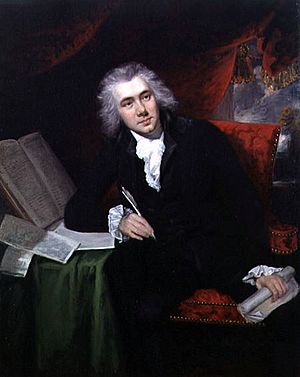
The movement to end slavery was led by Quakers and other Protestant groups. William Wilberforce, a member of Parliament, became the main voice for ending the slave trade in Britain.
His Slave Trade Act 1807 stopped the slave trade in the British Empire. But it wasn't until the Slavery Abolition Act 1833 that slavery itself was finally ended, though gradually. Landowners in the British West Indies lost their unpaid workers, so they received a large amount of money (about £20 million) as compensation. Former enslaved people received no money.
The Royal Navy created the West Africa Squadron in 1808 to stop the Atlantic slave trade. This squadron patrolled the coast of West Africa, stopping slave ships from various countries.
Even the Church of England was involved in slavery. The Anglican Church's Society for the Propagation of the Gospel in Foreign Parts owned sugar plantations in the West Indies with enslaved people. When slavery was ended, the British government paid compensation to slave owners, including the Church.
Economic Impact of Slavery
Historians and economists have discussed how slavery affected Great Britain and its colonies. Some believe it helped create the money that funded the Industrial Revolution. Enslaved labor was crucial for the early colonies, providing workers for plantations. It also produced major goods like coffee, cotton, rum, sugar, and tobacco that were traded worldwide.
However, other experts, like economist Thomas Sowell, argue that at its peak in the 1700s, profits from British slave traders were only a small part of Britain's total investment.
In recent years, many institutions have looked into their past connections to slavery. For example, English Heritage published a book about links between slavery and British country houses. Jesus College is studying its legacy of slavery. The Church of England, the Bank of England, Lloyd's of London, and Greene King have all apologized for their historical ties to slavery.
University College London has created a database to explore the many ways slavery impacted Britain.
Modern Slavery Today
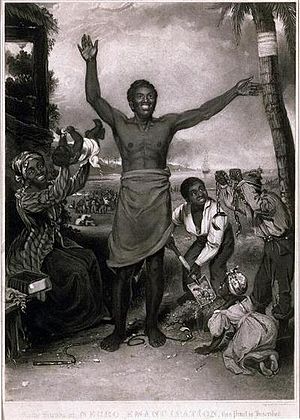
Sadly, modern slavery still exists, even in the UK. People living in the UK are often targeted. In 2021, British citizens were the most common group identified as potential victims. Forced labor is a main type of modern slavery affecting adults. Males are often affected more than females, both adults and children.
Because modern slavery is a hidden crime, it's hard to know exactly how many victims there are. In 2018, the Global Slavery Index estimated about 136,000 victims in the UK. Earlier research in 2015 estimated around 10,000 to 13,000 potential victims.
See also
- Centre for the Study of the Legacies of British Slavery
- Slave Trade Acts
- Slavery at common law
- Slavery in Ireland
- Somerset v Stewart
|


